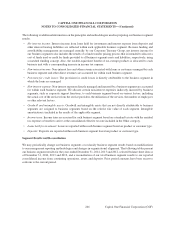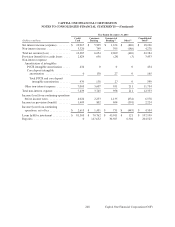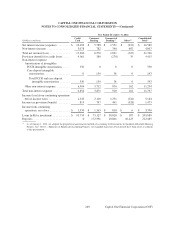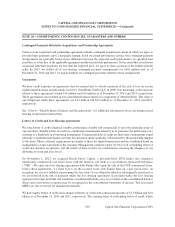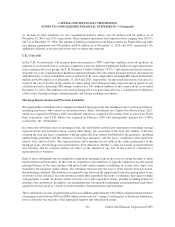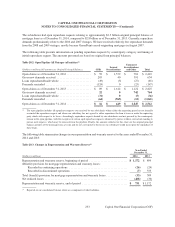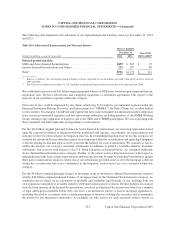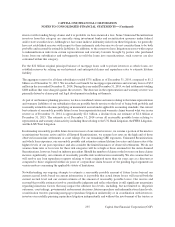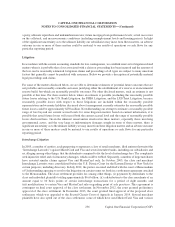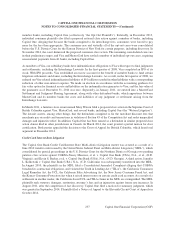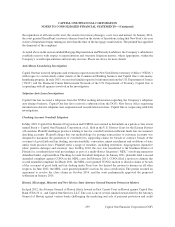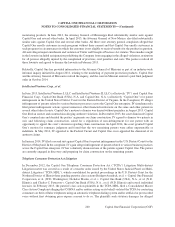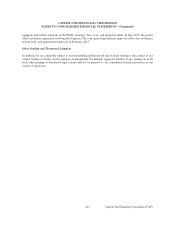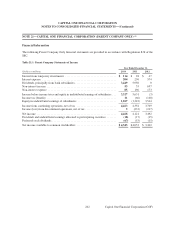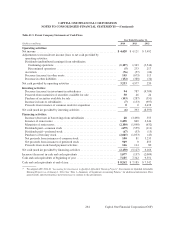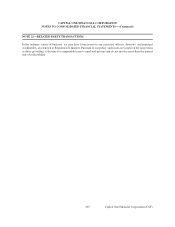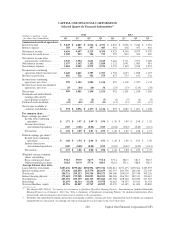Capital One 2014 Annual Report Download - page 278
Download and view the complete annual report
Please find page 278 of the 2014 Capital One annual report below. You can navigate through the pages in the report by either clicking on the pages listed below, or by using the keyword search tool below to find specific information within the annual report.a party; ultimate repurchase and indemnification rates; future mortgage loan performance levels; actual recoveries
on the collateral; and macroeconomic conditions (including unemployment levels and housing prices). In light
of the significant uncertainty as to the ultimate liability our subsidiaries may incur from these matters, an adverse
outcome in one or more of these matters could be material to our results of operations or cash flows for any
particular reporting period.
Litigation
In accordance with the current accounting standards for loss contingencies, we establish reserves for litigation related
matters when it is probable that a loss associated with a claim or proceeding has been incurred and the amount of
the loss can be reasonably estimated. Litigation claims and proceedings of all types are subject to many uncertain
factors that generally cannot be predicted with assurance. Below we provide a description of potentially material
legal proceedings and claims.
For some of the matters disclosed below, we are able to determine estimates of potential future outcomes that are
not probable and reasonably estimable outcomes justifying either the establishment of a reserve or an incremental
reserve build, but which are reasonably possible outcomes. For other disclosed matters, such an estimate is not
possible at this time. For those matters below where an estimate is possible (excluding the reasonably possible
future losses relating to the U.S. Bank Litigation, the FHFA Litigation, and the LXS Trust Litigation, because
reasonably possible losses with respect to those litigations are included within the reasonably possible
representation and warranty liabilities discussed above) management currently estimates the reasonably possible
future losses could be approximately $250 million. Notwithstanding our attempt to estimate a reasonably possible
range of loss beyond our current accrual levels for some litigation matters based on current information, it is
possible that actual future losses will exceed both the current accrual level and the range of reasonably possible
losses disclosed here. Given the inherent uncertainties involved in these matters, especially those involving
governmental actors, and the very large or indeterminate damages sought in some of these matters, there is
significant uncertainty as to the ultimate liability we may incur from these litigation matters and an adverse outcome
in one or more of these matters could be material to our results of operations or cash flows for any particular
reporting period.
Interchange Litigation
In 2005, a number of entities, each purporting to represent a class of retail merchants, filed antitrust lawsuits (the
“Interchange Lawsuits”) against MasterCard and Visa and several member banks, including our subsidiaries and
us, alleging among other things, that the defendants conspired to fix the level of interchange fees. The complaints
seek injunctive relief and civil monetary damages, which could be trebled. Separately, a number of large merchants
have asserted similar claims against Visa and MasterCard only. In October 2005, the class and merchant
Interchange Lawsuits were consolidated before the U.S. District Court for the Eastern District of New York for
certain purposes, including discovery. In July 2012, the parties executed and filed with the court a Memorandum
of Understanding agreeing to resolve the litigation on certain terms set forth in a settlement agreement attached
to the Memorandum. The class settlement provides for, among other things, (i) payments by defendants to the
class and individual plaintiffs totaling approximately $6.6 billion; (ii) a distribution to the class merchants of an
amount equal to 10 basis points of certain interchange transactions for a period of eight months; and
(iii) modifications to certain Visa and MasterCard rules regarding point of sale practices. This agreement is
contingent on final court approval of the class settlement. In November 2012, the court granted preliminary
approval of the class settlement. In December 2013, the court granted final approval of the proposed class
settlement, which was appealed to the Second Circuit Court of Appeals in January 2014. Several merchant
plaintiffs have also opted out of the class settlement, some of which have sued MasterCard, Visa and various
256
CAPITAL ONE FINANCIAL CORPORATION
NOTES TO CONSOLIDATED FINANCIAL STATEMENTS—(Continued)
Capital One Financial Corporation (COF)


